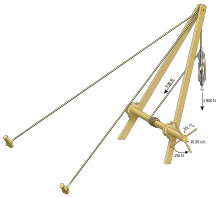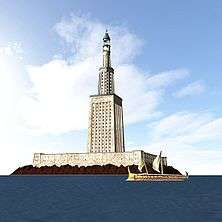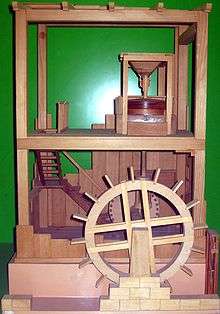| Technology |
Date |
Description |
|
| Streets |
c. 400 BC |
Example: The Porta Rosa (4th–3rd century BC) was the main street of Elea (Italy) and connected the northern quarter to the southern quarter. The street is 5 meters wide. At its steepest, it has an inclination of 18%. It is paved with limestone blocks, griders cut in square blocks, and on one side a small gutter for the drainage of rain water. The building is dated during the time of the reorganization of the city during Hellenistic age. (4th to 3rd centuries BC) |
 |
| Cartography |
c. 600 BC |
First widespread amalgamation of geographical maps developed by Anaximander. |
|
| Rutway |
c. 600 BC |
The 6 to 8.5 km long Diolkos represented a rudimentary form of railway.[6] |
 |
| Caliper |
6th century BC |
Earliest example found in the Giglio wreck near the Italian coast. The wooden piece already featured one fixed and a movable jaw.[7][8] |
|
| Truss roof |
550 BC[9] |
See List of Greco-Roman roofs |
|
| Crane |
c. 515 BC |
Labor-saving device that allowed the employment of small and efficient work teams on construction sites. Later winches were added for heavy weights. |
 |
| Escapement |
3rd century BC |
Described by the Greek engineer Philo of Byzantium (3rd century BC) in his technical treatise Pneumatics (chapter 31) as part of a washstand automaton for guests washing their hands. Philon's comment that "its construction is similar to that of clocks" indicates that such escapement mechanisms were already integrated in ancient water clocks.[10] |
 |
| Tumbler lock |
c. 5th century BC |
The tumbler lock, as well as other varieties of lock, was introduced in Greece in the 5th century BC. |
|
| Gears |
c. 5th century BC |
Developed further than in prehistoric times for a variety of practical purposes. |
|
| Plumbing |
c. 5th century BC |
Excavations at Olympus, as well as Athens, have revealed extensive plumbing systems for baths, fountains, and personal use. |
|
| Spiral staircase |
480–470 BC |
The earliest spiral staircases appear in Temple A in Selinunte, Sicily, to both sides of the cella. The temple was constructed around 480–470 BC.[11] |
 |
| Urban planning |
c. 5th century BC |
Miletus is one of the first known towns in the world to have a grid-like plan for residential and public areas. It accomplished this feat through a variety of related innovations in areas such as surveying. |
|
|
| Winch |
5th century BC |
The earliest literary reference to a winch can be found in the account of Herodotus of Halicarnassus on the Persian Wars (Histories 7.36), where he describes how wooden winches were used to tighten the cables for a pontoon bridge across the Hellespont in 480 BC. Winches may have been employed even earlier in Assyria, though. By the 4th century BC, winch and pulley hoists were regarded by Aristotle as common for architectural use (Mech. 18; 853b10-13).[12] |
|
| Showers |
4th century BC |
A shower room for female athletes with plumbed-in water is depicted on an Athenian vase. A whole complex of shower-baths was also found in a 2nd-century BC gymnasium at Pergamum.[13] |
|
| Central heating |
c. 350 BC |
Great Temple of Ephesus was warmed by heated air that was circulated through flues laid in the floor. |
|
| Lead sheathing |
c. 350 BC |
To protect a ship's hull from boring creatures; see Kyrenia ship |
|
| Astrolabe |
c. 300 BC |
First used around 200 BC by astronomers in Greece. Used to determine the altitude of objects in the sky. |
|
| Canal lock |
early 3rd century BC |
Built into Ancient Suez Canal under Ptolemy II (283–246 BC).[14][15][16] |
|
| Ancient Suez Canal |
early 3rd century BC |
Opened by Greek engineers under Ptolemy II (283–246 BC), following earlier, probably only partly successful attempts.[17] |
|
| Lighthouse |
c. 3rd century BC |
The Lighthouse of Alexandria was designed and constructed by Sostratus of Cnidus. |
 |
| Water wheel |
3rd century BC |
First described by Philo of Byzantium (c. 280–220 BC).[18] |
|
| Alarm clock |
3rd century BC |
The Hellenistic engineer and inventor Ctesibius (fl. 285–222 BC) fitted his clepsydras with a dial and pointer for indicating the time, and added elaborate "alarm systems, which could be made to drop pebbles on a gong, or blow trumpets (by forcing bell-jars down into water and taking the compressed air through a beating reed) at pre-set times" (Vitruv 11.11).[19] |
|
| Odometer |
c. 3rd century BC |
Odometer, a device used in the late Hellenistic time and by Romans for indicating the distance travelled by a vehicle. It was invented sometime in the 3rd century BC. Some historians attribute it to Archimedes, others to Heron of Alexandria. It helped revolutionize the building of roads and travelling by them by accurately measuring distance and being able to carefully illustrate this with a milestone. |
|
| Chain drive |
3rd century BC |
First described by Philo of Byzantium, the device powered a repeating crossbow, the first known of its kind.[20] |
|
| Cannon |
c. 3rd century BC |
Ctesibius of Alexandria invented a primitive form of the cannon, operated by compressed air. |
|
| Double-action principle |
3rd century BC |
Universal mechanical principle that was discovered and first applied by the engineer Ctesibius in his double action piston pump, which was later developed further by Heron to a fire hose (see below).[21] |
|
| Levers |
c. 260 BC |
First described about 260 BC by the ancient Greek mathematician Archimedes. Although used in prehistoric times, they were first put to practical use for more developed technologies in Ancient Greece. |
|
| Water mill |
c. 250 BC |
The use of water power was pioneered by the Greeks: The earliest mention of a water mill in history occurs in Philo's Pneumatics, previously been regarded as a later Arabic interpolation, but according to recent research to be of authentic Greek origin.[1][22] |
|
| Three-masted ship (mizzen) |
c. 240 BC: |
First recorded for Syracusia as well as other Syracusan (merchant) ships under Hiero II of Syracuse[23] |
|
| Gimbal |
3rd century BC |
The inventor Philo of Byzantium (280–220 BC) described an eight-sided ink pot with an opening on each side, which can be turned so that any face is on top, dip in a pen and ink it-yet the ink never runs out through the holes of the side. This was done by the suspension of the inkwell at the center, which was mounted on a series of concentric metal rings which remained stationary no matter which way the pot turns itself.[24] |
 |
| Fore-and-aft rig (spritsail) |
2nd century BC |
Spritsails, the earliest fore-and-aft rigs, appeared in the 2nd century BC in the Aegean Sea on small Greek craft.[25] |
 |
| Air and water pumps |
c. 2nd century BC |
Ctesibius and various other Greeks of Alexandria of the period developed and put to practical use various air and water pumps which served a variety of purposes, such as a water organ. |
|
| Sakia gear |
2nd century BC |
First appeared in 2nd-BC Hellenistic Egypt, where pictorial evidence already showed it fully developed[26] |
|
| Surveying tools |
c. 2nd century BC |
Various records relating to mentions of surveying tools have been discovered, mostly in Alexandrian sources, these greatly helped the development of the precision of Roman aqueducts. |
|
| Analog computers |
c. 150 BC |
In 1900–1901, the Antikythera mechanism was found in the Antikythera wreck. It is thought that this device was an analog computer designed to calculate astronomical positions and was used to predict lunar and solar eclipses based on Babylonian arithmetic-progression cycles. |
 |
| Fire hose |
1st century BC |
Invented by Heron in the basis of Ctesibius' double action piston pump.[21] Allowed for more efficient fire fighting. |
|
| Vending machine |
1st century BC |
The first vending machine was described by Heron of Alexandria. His machine accepted a coin and then dispensed a fixed amount of holy water. When the coin was deposited, it fell upon a pan attached to a lever. The lever opened up a valve, which let some water flow out. The pan continued to tilt with the weight of the coin until it fell off, at which point a counter-weight would snap the lever back up and turn off the valve.[21] |
|
| Wind vane |
50 BC |
The Tower of the Winds on the Roman agora in Athens featured atop a wind vane in the form of a bronze Triton holding a rod in his outstretched hand rotating to the wind blowing. Below, its frieze was adorned with the eight wind deities. The 8 m high structure also featured sundials and a water clock inside dates from around 50 BC.[27] |
|
| Clock tower |
50 BC |
See Clock tower.[28] |
 |
| Automatic doors |
c. 1st century AD |
Heron of Alexandria, a 1st-century BC inventor from Alexandria, Egypt, created schematics for automatic doors to be used in a temple with the aid of steam power.[21] |
|









